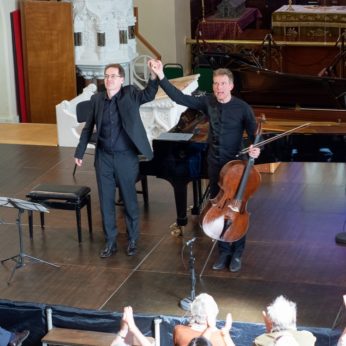Composer: Fryderyk Chopin (b. 1810 - d. 1849)
Performance date: 01/07/2019
Venue: St. Brendan’s Church
Composition Year: 1847
Duration: 00:32:00
Recording Engineer: Gar Duffy, RTÉ
Instrumentation: vc, pf
Instrumentation Category:Duo
Artists:
Dénes Várjon -
[piano]
Johannes Moser -
[cello]

Fryderyk Chopin [1810-1849]
Sonata for Cello and Piano in G minor op. 65 [1847]
• Allegro moderato
• Scherzo
• Largo
• Finale
Chopin spent nearly all his adult life in Paris, arriving there in October 1831 and dying there in the same month eighteen years later. During all these years he only played in public fifteen times, confining his playing to salons where he knew everyone in the room. This was partly due to nervousness but mostly due to his style of play being unsuitable for large halls, whereas it was highly effective in the chamber music setting of the salon. His last public performance in Paris in February 1848 included the last three movements of this work. We undoubtedly owe this work to his long friendship with the cellist Auguste Franchomme.
It was composed in 1845-6 just as his long liaison with George Sands was coming to its bitter end. Until then his entire output had concentrated on the refinement and perfection of a single medium so the composition of a full-blown duo sonata for the first time in his life was bound to cause him anguish. With my cello sonata I am now contented, now discontented. I throw it in a corner and then pick it up again, so wrote the unhappy composer in October 1846.
Stylistically the work casts glances at Schumann and Mendelssohn and back to his own early chamber works, though the substance of the sonata is clearly the work of a master. It is probably the least known of his masterpieces and we are fortunate that today’s two musicians have undertaken to unravel its mysteries for us. Strictly speaking the medium was not new to him as he had composed two lightweight works in his youth, but in those pieces he had not begun to tackle the complex problem of combining two such different instruments on anything like equal terms.
The sonata is in four movements though the opening movement is longer than the other three put together. This movement’s close-knit themes underpin a clear formal design including a repeated exposition. The first subject is given out by the piano alone before being joined by the cello and it is given a substantial and passionate working-out before the second theme makes its gentle appearance after the music comes to an almost complete halt. The distinctive first theme is excluded from the development and the recapitulation, though material from the piano’s opening statement is recalled at the opening of both these sections. It gives some idea of Chopin’s attitude to his music that he was prepared to leave the security of his own instrument to engage with a string sonata. Among the sketches for the Cello Sonata are drafts of a work for violin and piano so he may well have intended to continue along this path if revolution, illness and death had not intervened.
The Scherzo has the character of a mazurka, a Polish dance that Chopin had made peculiarly his own. The central section has a sensually lyrical theme for the cello, which is driven away by the brief return of the dance. So we are prepared somewhat for the ethereal nocturne that is the Largo, two whispering and caressing voices that tell us why we are addicted to Chopin. The opening of the lively finale is necessarily brutal, but its well contrasted sonata-rondo form provides excitement, virtuosity and even moments of lyricism to round off the work.
Francis Humphrys
Copyright © 2024 West Cork Music. All rights reserved.
Designed and developed by Matrix Internet